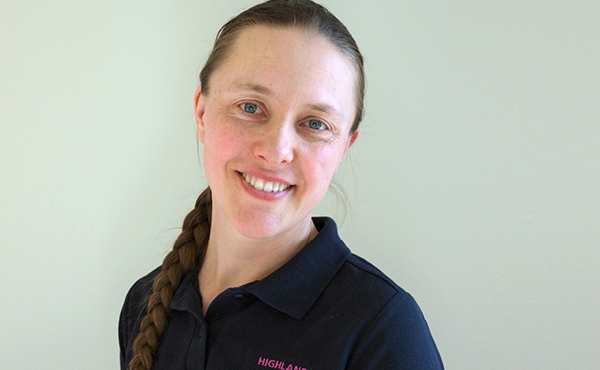Supervised learning events
Supervised Learning Events (SLEs) should be used by anaesthetists in training and trainers to promote professional educational discussions and guide future learning, with the emphasis on feedback. Developmental conversations that enhance the improvement in performance that comes with repeated cycles of experience, reflection, conceptualisation, and application. Feedback should include both the specialty specific and generic professional aspects of performance.
Features that are key to making SLEs effective are that the conversation happens soon after the observed activity, that this dialogue is aided by a credible facilitator, and that the conversation is seen as part of a continual process of development, rather than an assessment of performance at a single point in time.
It is important to note that one SLE can provide evidence for more than one of the Key Capabilities and there is no minimum number of SLE requirement for any of the Domains of Learning.
Anaesthetists in training and trainers will be familiar with the tools such as A-CEX, DOPS, CBD and ALMAT, however these have been updated to emphasise the importance of feedback and include a revised supervision scale.
A new SLE has been introduced for the formative assessment of Quality Improvement activities. This is known as the Anaesthesia-Quality Improvement Project Assessment Tool (A-QIPAT).
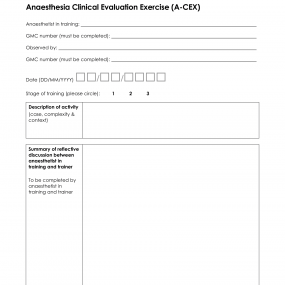
The A-CEX is used during clinical sessions, and the assessments are based on the observed performance of the anaesthetist in training’s skills, attitudes and behaviours, and knowledge. It looks at the anaesthetist in training’s performance in a case rather than focusing on a specific procedure; for example, the anaesthetic management of a patient with renal failure.
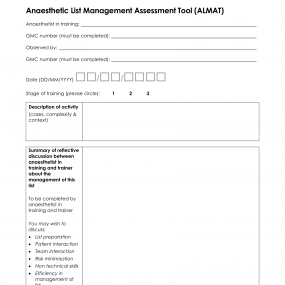
Similar to the A-CEX, the ALMAT is designed to assess and facilitate feedback on an anaesthetist in training’s performance during their practice. When undertaking an ALMAT, an anaesthetist in training is given responsibility for the running of a surgical list according to their level of competence. This tool is particularly appropriate for more senior anaesthetists in training and allows assessment of both clinical and non-clinical skills. Anaesthetists in training should request this assessment before the start of the list, and they may be assessed either by the trainer with direct responsibility for that list, or it may be possible for an anaesthetist in training working with indirect supervision to be assessed by the nominated supervising consultant for that area.
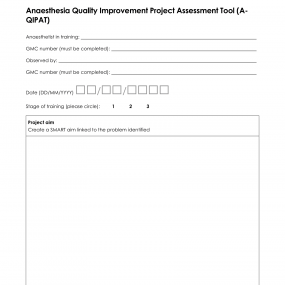
Quality improvement is a key element of professional practice. The A-QIPAT form is introduced in this curriculum to enhance assessment of this learning outcome. This assessment allows individuals who have worked with the anaesthetist in training to comment on their performance as part of a quality improvement project. This is a very useful way to provide the anaesthetist with feedback that is specific to their performance in quality improvement projects.
In September 2020, the RCoA launched Raising the Standards: RCoA Quality Improvement Compendium. This innovative resource provides further guidance for QI and audit activities across all areas of anaesthesia and is also mapped to national programmes such as the National Audit Project recommendations and National Emergency Laparotomy Audit (NELA). The College's Quality Improvement work aims to facilitate and strengthen delivery of comprehensive improvement and safety programs aligned with our professional standards, accreditation and education. Find out more about the College's QI work.
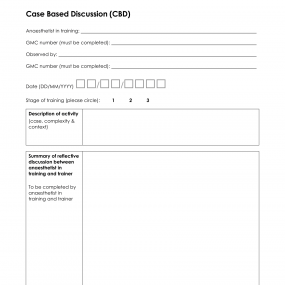
The CBD is usually used away from the clinical environment – it allows the assessor to question the anaesthetist in training about a clinical episode in order to assess their knowledge and rationale for their actions, or what they would do if presented with the clinical scenario. When undertaking a CBD, the anaesthetist in training should bring the case notes and/or anaesthetic chart of a case that they wish to discuss in retrospect. The conduct and management of the case as well as the standards of documentation and follow up should be discussed. CBDs offer an opportunity to discuss a case in depth and to explore thinking, judgement and knowledge. They also provide a useful forum for reflecting on practice, especially in cases of critical incidents.
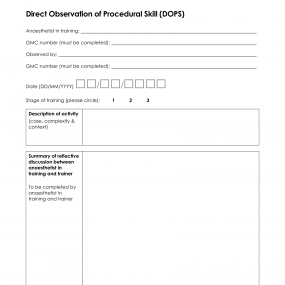
The DOPS tool is used for assessing performance in procedures, such as arterial cannulation or epidural insertion. This tool is therefore more suited to Stage 1 training rather than Stage 2 or 3, except for new areas of anaesthetic practice, which should focus on higher level skills. They are useful for assessing anaesthetists in training who are learning a new skill eg nerve block.


